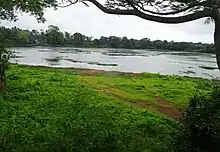Neura, Goa
Neura[lower-alpha 1] (English: /njurɑː/ ⓘ; also known as Velakula – the official name until 1310 CE) is a village located in the Tiswadi taluka of Goa, India. During the reign of the Kadamba dynasty, the village was a bustling centre, primarily due to its Naval quarters. It was also a center for learned Brahmin-Sinais.
Neura
Velakula | |
|---|---|
Village | |
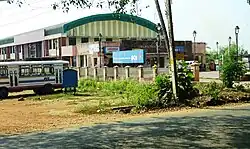 Neura Panchayat Ghar (2017) | |
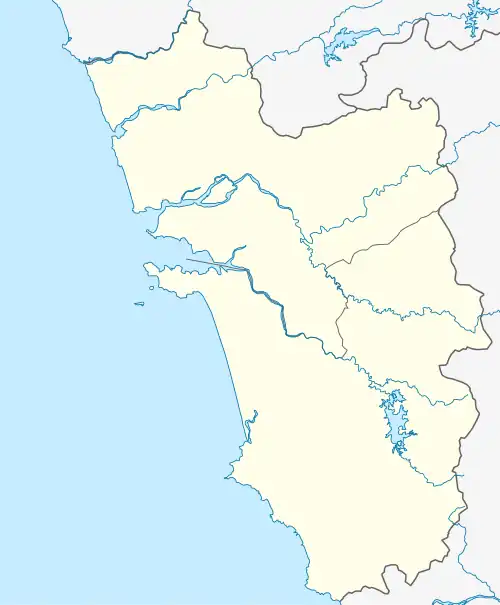 Neura  Neura | |
| Coordinates: 15°26′35.24″N 73°55′4.62″E | |
| Country | India |
| State | Goa |
| District | North Goa |
| Sub-district | Tiswadi |
| Government | |
| • Type | Gram panchayat |
| • Body | Village Panchayat |
| • Member of Goa Legislative Assembly | Viresh Borkar (RGP) |
| • Sarpanch | Usha Anand Naik |
| • Deputy Sarpanch | Vinod Vaikunt Kamat |
| Area | |
| • Land | 28 km2 (11 sq mi) |
| Population (2018) | |
| • Total | 5,000 |
| Website | www |
History
Early history
In the era of the Kadamba dynasty, a port thrived near the present-day Agaçaim Beach. Remnants of the ancient port wall are still sometimes visible during low tides. The shipyards, which were the hub of shipbuilders and sailors, were situated a short distance away in the village of Neura, known in those times as Velakula.[2]
In the Gopaka plate inscription, it is documented that Jaykeshi I took action in AD 1052 by establishing a fleet at Velakula, a port situated on the banks of the Zuari River. Velakula was a maritime trading hub that had historical connections with the Tajjika or Arab community, and it was governed by the Goa Shilaharas.[3]
Portuguese period
In the historical annals predating Portuguese dominion, the village of Neura occupied a unique position within the region of Goa, owing to its strategic location between two ancient capitals, Gopakapattana and Velha Goa (Old Goa). Neura not only possessed expansive khazan lands, but it also encompassed two distinct gaunkarias or comunidade villages known as Neura-O-Grande and Neura-O-Pequeno.[4] Additionally, the village had an important harbor.[5]
Contemporary period
In the annals of Goa's history, the village played a significant role. Its contributions to agriculture have been chronicled throughout the years. However, according to local residents John and Maria Gonsalves from Guddivaddo, the advent of pisciculture brought about a drastic transformation that irreparably impacted Neura's agricultural pursuits.[5]
Many residents expressed sadness over the negative impact of pisciculture, a practice adopted by a small group of individuals, on the village's agriculture. According to Vinod Kamat, the former sarpanch, the once rich agricultural fields of Neura, which covered an area of 10 km (6.2 mi), have been completely destroyed as a result of illegal and unlawful fishing activities taking place in the village.[5]
Fr. Mousinho Athaide, the parish priest of St. John the Evangelist church, shared the sentiment of distress. He highlighted that in addition to the devastation caused to agriculture, Neura's khazans have also suffered damage due to the lack of action taken by the panchayat and comunidades against those responsible for the wrongdoings.[5]
Etymology
Oscar de Noronha, a resident of Miramar and a native of Neura, expressed his belief regarding the origin of the term 'Neura.' In Noronha's view, the origins of the word can be traced back to the villagers' cultivation of a specific variety of rice called 'nevri.' However, alternative theories propose that 'Neura' derived its name from 'navrak,' which translates to 'town of boats.' This idea finds support in the historical context of the region, as the area known today as 'Velfali khazan' served as a safe harbor for ships during the Kadamba era.[5]
Geography
The village encompasses a land area spanning 28 square kilometers and serves as a residence for approximately 5,000 inhabitants. It shares its borders with the neighboring villas of Agasaim, Goa Velha, and Azossim-Mandur. Moreover, to the south lies the Zuari River.[5]
Wards
The village is organized into a village panchayat consisting of seven wards. Within these wards, known as "vadde" (singular: vaddo), Neura is further divided into distinct traditional village units. Some of these vadde include Shenvai-vaddo,[6] Igorjevaddo, Padri Bhat, Shenkrem Bhat, Guddivaddo, Dhondea Bhat, Neura Pequeno, and Dev Bhat.[5]
Landmarks and education
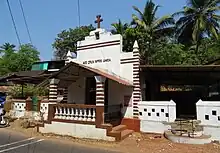
Among the landmarks in Neura is the Shri Dhondeshwar Temple. The village is also home to two educational institutions, namely the Dayanand Arya High School and the Azmane High School.[7]
Architecture
.jpg.webp)
In close proximity to the ruins of the Ravalnath Temple, which suffered destruction during the Portuguese era, stands the historic Church of St. John the Evangelist, which was constructed between the years 1541 and 1542.[8]
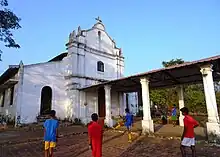
Additionally, near the outskirts of Neura village, the St. Sebastian Chapel can be found, dating back to the 17th century. This chapel, perched atop a hillock. Nearby is the Chapel of Our Lady of Miracles which was constructed in 1796.[8]
Notable people
- Bernardo Peres da Silva (1775–1844) – 18th-century Goan politician and former medical practitioner, who served as a Governor of Portuguese India.[9]
- Viresh Borkar – Indian politician and businessman, who currently serves as a member of the Goa Legislative Assembly, representing the St. Andre Assembly constituency.[10]
Further reading
- Moraes, George M. (1990). The Kadamba Kula: A History of Ancient and Mediaeval Karnataka. Asian Educational Services. ISBN 9788120605954.
- Kadamb, S. G. (2010). The Kadambas of Goa. Panjim: Broadway Publishing House. ISBN 9789380837109.
Notes
- also referred to as Island of Neura.[1]
References
- Bayly, C. A. (November 10, 2011). Recovering Liberties: Indian Thought in the Age of Liberalism and Empire. Cambridge University Press. ISBN 9781139505185. Archived from the original on August 17, 2023. Retrieved August 17, 2023 – via Google Books.
- "Ribeira Grande: The Royal Dockyard of Goa & Medieval Shipbuilding". October 21, 2021. Archived from the original on August 13, 2023. Retrieved August 13, 2023.
- Desk, N. T. (2017-06-26). "Why Hindu Kadambas Allied With Muslims – The Navhind Times". Archived from the original on 2023-08-15. Retrieved 2023-08-15.
- Bhatt, S. C. (2005). Land and people of Indian states and union territories : (in 36 volumes). Gyan Publishing House. ISBN 978-81-7835-356-2. Archived from the original on 2023-08-17. Retrieved 2023-08-14.
- "A village where fields lie under water - Times of India". The Times of India. 2018-03-27. Archived from the original on 2023-08-12. Retrieved 2023-08-12.
- "THE KADAMBAS OF GOA – Pilar Seminary Museum". Archived from the original on 2023-08-16. Retrieved 2023-08-16.
- "Welcome To Village Panchayat Neura". www.vpneura.com. Archived from the original on 2021-12-29. Retrieved 2023-08-12.
- "Neura village in Goa, Goa Neura village information, Neura church of St. John the Evangelist, Places to visit in Neura Goa". www.goaholidayhomes.com. Archived from the original on 2023-08-12. Retrieved 2023-08-12.
- "BPS - the first Goan Governor". oHeraldo. Archived from the original on 2023-08-13. Retrieved 2023-08-13.
- "Inspired by freedom fighter grandfather, Viresh Borkar chose revolutionary path". The Times of India. 2022-03-19. ISSN 0971-8257. Archived from the original on 2023-08-13. Retrieved 2023-08-13.
